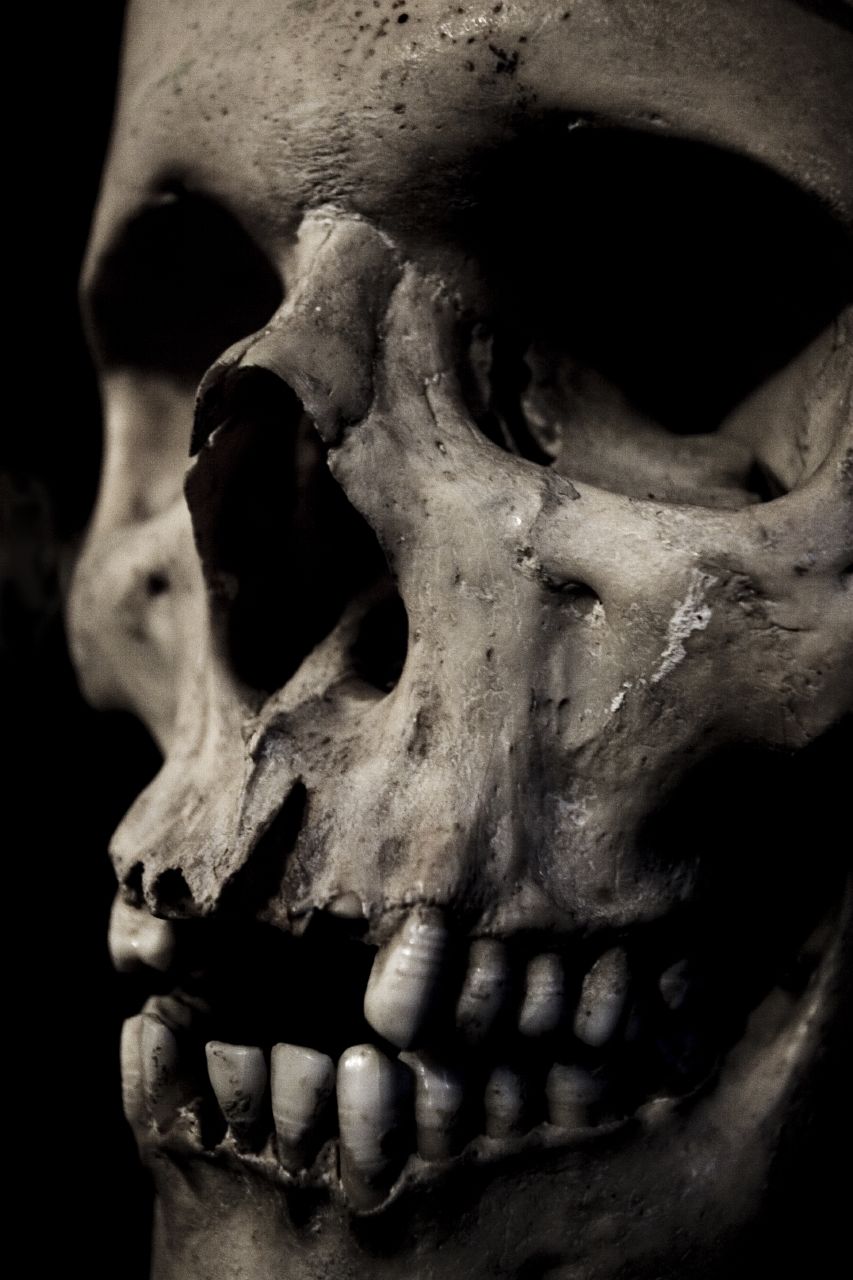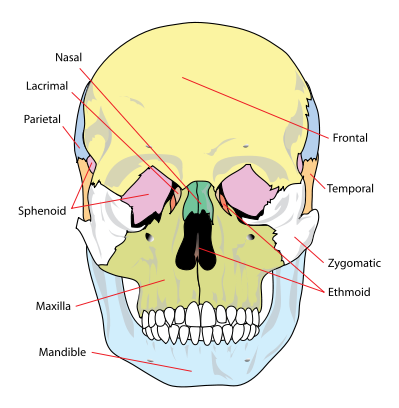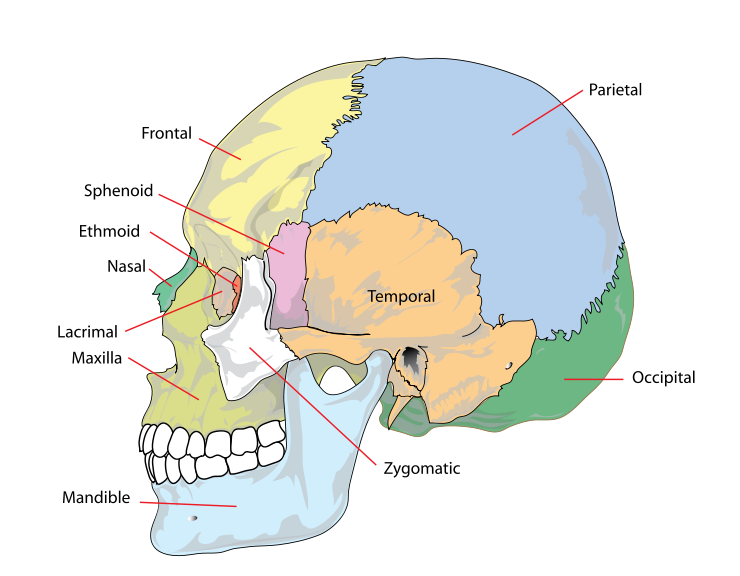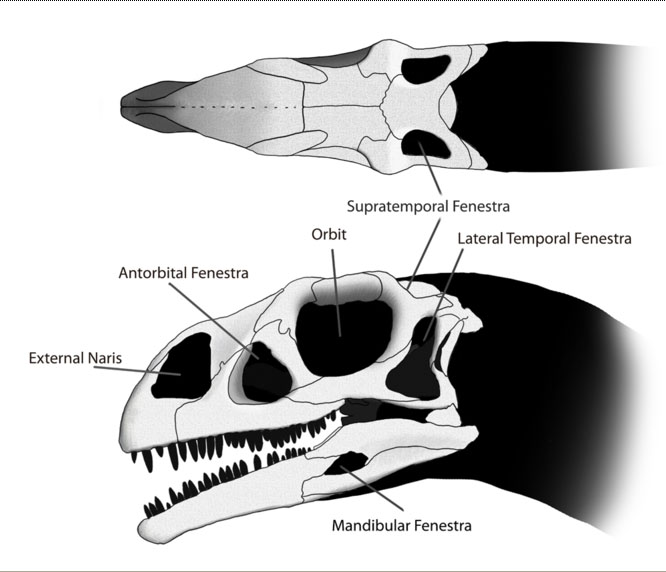Skull
 From Wikidoc - Reading time: 4 min
From Wikidoc - Reading time: 4 min
|
WikiDoc Resources for Skull |
|
Articles |
|---|
|
Media |
|
Evidence Based Medicine |
|
Clinical Trials |
|
Ongoing Trials on Skull at Clinical Trials.gov Clinical Trials on Skull at Google
|
|
Guidelines / Policies / Govt |
|
US National Guidelines Clearinghouse on Skull
|
|
Books |
|
News |
|
Commentary |
|
Definitions |
|
Patient Resources / Community |
|
Directions to Hospitals Treating Skull Risk calculators and risk factors for Skull
|
|
Healthcare Provider Resources |
|
Continuing Medical Education (CME) |
|
International |
|
|
|
Business |
|
Experimental / Informatics |
Editor-In-Chief: C. Michael Gibson, M.S., M.D. [1]

Overview[edit | edit source]
The skull is a bony structure found in many animals which serves as the general framework for the head. The skull supports the structures of the face and protects the head against injury.
The skull can be subdivided into two parts: the cranium and the mandible. A skull that is missing a mandible is only a cranium; this is the source of a very commonly made error in terminology. Those animals having skulls are called craniates.
Protection of the brain is only one part of the function of a bony skull. For example, a fixed distance between the eyes is essential for stereoscopic vision, and a fixed position for the ears helps the brain to use auditory cues to judge direction and distance of sounds. In some animals, the skull also has a defensive function (e.g. horned ungulates); the frontal bone is where horns are mounted.
Human skulls[edit | edit source]


In humans, the adult skull is normally made up of 22 bones. Except for the mandible, all of the bones of the skull are joined together by sutures, rigid articulations permitting very little movement. Eight bones form the neurocranium (braincase), a protective vault surrounding the brain. Fourteen bones form the splanchnocranium, the bones supporting the face. Encased within the temporal bones are the six ear ossicles of the middle ears, though these are not part of the skull. The hyoid bone, supporting the tongue, is usually not considered as part of the skull either, as it does not articulate with any other bones.
The skull contains the sinus cavities, which are air-filled cavities lined with respiratory epithelium, which also lines the large airways. The exact functions of the sinuses are unclear; they may contribute to lessening the weight of the skull with a minimal reduction in strength,or they may be important in improving the resonance of the voice. In some animals, such as the elephant, the sinuses are extensive. The elephant skull needs to be very large, to form an attachment for muscles of the neck and trunk, but is also unexpectedly light; the comparatively small brain-case is surrounded by large sinuses which reduce the weight. The meninges are the three layers, or membranes, which surround the structures of the nervous system. They are known as the dura mater, the arachnoid mater and the pia mater. Other than being classified together, they have little in common with each other.
In humans, the anatomical position for the skull is the Frankfurt plane, where the lower margins of the orbits and the upper borders of the ear canals are all in a horizontal plane. This is the position where the subject is standing and looking directly forward. For comparison, the skulls of other species, notably primates and hominids, may sometimes be studied in the Frankfurt plane. However, this does not always equate to a natural posture in life.
Possible types of skull fractures[edit | edit source]
Other skulls[edit | edit source]
Temporal Fenestra[edit | edit source]

The temporal fenestra are anatomical features of the amniote skull, characterised by bilaterally symmetrical holes (fenestrae) in the temporal bone. Depending on the lineage of a given animal, two, one, or no pairs of temporal fenestrae may be present, above or below the postorbital and squamosal bones. The upper temporal fenestrae are also known as the supratemporal fenestrae, and the lower temporal fenestrae are also known as the infratemporal fenestrae. The presence and morphology of the temporal fenestra is critical for taxonomic classification of the synapsids, of which mammals are part.
Physiological speculation associates it with a rise in metabolic rates and an increase in jaw musculature. The earlier amniotes of the Carboniferous did not have temporal fenestrae but the more advanced sauropsids and synapsids did. As time progressed, sauropsids' and synapsids' temporal fenestrae became more modified and larger to make stronger bites and more jaw muscles. Dinosaurs, which are sauropsids, have large advanced openings and their descendants, the birds, have temporal fenestrae which have been modified. Mammals, which are synapsids, possess no fenestral openings in the skull, as the trait has been modified. They do, though, still have the temporal orbit (which resembles an opening) and the temporal muscles. It is a hole in the head and is situated to the rear of the orbit behind the eye.
See also[edit | edit source]
- Bone terminology
- Anatomical terms of location
- Head and neck anatomy
- Phrenology, the pseudoscientific process of determining personality from the shape of the head.
References[edit | edit source]
- White, T.D. 1991. Human osteology. Academic Press, Inc. San Diego, CA.
External links[edit | edit source]
- Animal Skull Collection (Over 300 animal skull images compiled by U.S. high-school teacher)
- Skull terminology site by Texas A&M
- Anatomy of cranial cavity.
- Dept of Anth Skull Module
- Skull Anatomy Tutorial.
ar:جمجمة
bg:Череп
ca:Crani
cs:Lebka
cy:Penglog
da:Kranium
de:Schädel
eo:Kranio
eu:Burezur
gl:Cranio
ko:두개골
hr:Lubanja
id:Tengkorak
os:Сæргæхц
is:Höfuðkúpa
it:Cranio
he:גולגולת
la:Calva
lt:Galvos griaučiai
hu:Koponya
nl:Schedel
no:Skalle
simple:Skull
sk:Lebka
fi:Pääkallo
sv:Kranium
th:กะโหลกศีรษะ
uk:Череп
 KSF
KSF